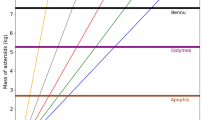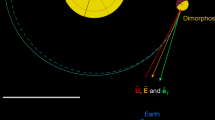Abstract
Deflecting potentially dangerous asteroids may not be an easy task due to the complexity of the system, as well as challenges such as monitoring and defining their future orbit, which can often be very sensitive to encounters with massive planets. Over the years, many proposals have been made to face the challenges and even deflect the asteroid from a possible collision with Earth. Within this scenario, we are proposing the use of the kinetic impact deflection technique combined with gravitational perturbations from the Earth. We assume the following scenario: the asteroid will have a closest approach to Earth and will move away again; however, in its next closest approach to Earth, it will collide with it. The proposal is to take advantage of the first maximum approach between the asteroid and the Earth, to apply a velocity variation on the asteroid that will have its effect intensified by the Swing-By with Earth. We will take the opportunity to understand how the planets can influence the results. Our results show that planets can change the results significantly. Another interesting result is that the minimum impulse to avoid Apophis collision has the magnitude of − 5 mm/s.




Similar content being viewed by others
Availability of data and materials
All data generated or analyzed during this study are included in this published article in the form of figures. For more information, contact Bruno Chagas Santos (bruno.ba.987@gmail.com or bruno.chagas@unesp.br).
References
Thomas J. Ahrens, Alan W. Harris, Deflection and fragmentation of near-Earth asteroids. Nature 360(6403), 429–433 (1992)
Smiriti Srivastava et al., Analysis of Technology, Economic, and Legislation Readiness Levels of Asteroid Mining Industry A Base for the Future Space Resource Utilization Missions. New Space 11(1), 21–31 (2023)
Vide. Hellgren, Asteroid mining: a review of methods and aspects. Student thesis series INES (2016)
Andrea Carusi et al., Deflecting NEOs in route of collision with the Earth. Icarus 159(2), 417–422 (2002)
AndyF. Cheng et al., Asteroid impact and deflection assessment mission. Acta Astronaut. 115, 262–269 (2015)
E.A. Gonzaga, A method of controlling asteroid collision with the Earth. Cosm. Res. 48, 459–466 (2010)
Anton Ledkov, et al. Small near Earth asteroids and gravity assist maneuvers as basic constituents of planetary defense against hazardous sky objects. SpaceOps 2014 Conference. (2014)
Claudio Maccone, Planetary defense from the nearest 4 lagrangian points plus rfi-free radioastronomy from the farside of the Moon: a unified vision. Acta Astronaut. 50(3), 185–199 (2002)
Andrew F. Cheng et al., DART mission determination of momentum transfer: Model of ejecta plume observations. Icarus 352, 113989 (2020)
Bruce A. Conway, Near-optimal deflection of earth-approaching asteroids. J. Guid. Control. Dyn. 24(5), 1035–1037 (2001)
Keith A. Holsapple, Kevin R. Housen, Momentum transfer in asteroid impacts. I. Theory and scaling. Icarus 221(2), 875–887 (2012)
Kevin R. Housen, Keith A. Holsapple, On the fragmentation of asteroids and planetary satellites. Icarus 84(1), 226–253 (1990)
J.P. Sanchez, Massimiliano Vasile, Gianmarco Radice, Consequences of asteroid fragmentation during impact hazard mitigation. J. Guid. Control. Dyn. 33(1), 126–146 (2010)
B.S. Chagas, A.F.B.A. Prado, O.C. Winter, Gravitational perturbations correlated with the asteroid kinetic impact deflection technique. Sci. Rep. 12(1), 11721 (2022)
B.S. Chagas, A.F.B.A. Prado, O.C. Winter, Deflecting an Asteroid on a Collision Course with Earth Using a Powered Swing-By Maneuver. Symmetry 14(8), 1658 (2022)
John E. Chambers, A hybrid symplectic integrator that permits close encounters between massive bodies. Mon. Not. R. Astron. Soc. 304(4), 793–799 (1999)
J.M.A. Danby, Book-review-fundamentals of celestial mechanics. Celest. Mech. Dyn. Astron. 50, 195 (1991)
Alessandra FS. Ferreira et al., Effects of the eccentricity of the primaries in powered Swing-By maneuvers. Adv. Space Res. 59(8), 2071–2087 (2017)
L.E. Bykova, T. Yu Galushina, Investigation of the motion of (99942) Apophis asteroid using the skif cyberia multiprocessor computing system. Cosm. Res. 48, 409–416 (2010)
Alessandra FS. Ferreira, Antonio FBA. Prado, Othon C. Winter, A numerical mapping of energy gains in a powered Swing-By maneuver. Nonlinear Dyn. 89, 791–818 (2017)
A.F.B.A. Prado, Powered swingby. J. Guid. Control. Dyn. 19(5), 1142–1147 (1996)
JonD. Giorgini et al., Predicting the Earth encounters of (99942) Apophis. Icarus 193(1), 1–19 (2008)
Funding
This publication has been supported by the RUDN University Scientific Projects Grant System, under Project No. 202235-2-000. The authors would like to thank FAPESP proc. 2016/024561-0 and 2018/17864-1; CNPq proc. 305210/2018-1 and 309089/2021-2; and CAPES for funding and contributing to this work.
Author information
Authors and Affiliations
Contributions
BSC wrote the main version of the manuscript, generated data, and prepared the figures. BSC, AFBAP, and OCW contributed on its conception and analysis, and interpretation of data and revisions. All authors have read and agreed to the published version of the manuscript.
Corresponding author
Ethics declarations
Conflict of interest
The authors declare that there is no conflict of interest.
Consent to participate/consent for publication
Not applicable.
Rights and permissions
Springer Nature or its licensor (e.g. a society or other partner) holds exclusive rights to this article under a publishing agreement with the author(s) or other rightsholder(s); author self-archiving of the accepted manuscript version of this article is solely governed by the terms of such publishing agreement and applicable law.
About this article
Cite this article
Chagas, B.S., Prado, A.F.B.A. & Winter, O.C. Studying the prevention of collision of asteroid Apophis with Earth by kinetic impact. Eur. Phys. J. Spec. Top. 232, 2975–2982 (2023). https://doi.org/10.1140/epjs/s11734-023-01034-w
Received:
Accepted:
Published:
Issue Date:
DOI: https://doi.org/10.1140/epjs/s11734-023-01034-w




